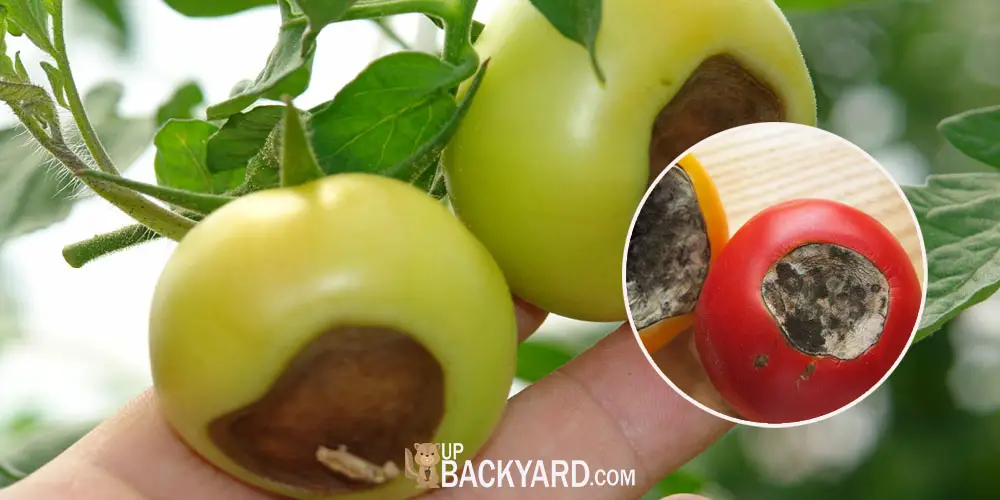When growing crops in a garden, pests and diseases are an unfortunate part of the process. However, even when you feel like you did everything correctly, there still can be issues with your vegetables.
For example, tomatoes are commonly susceptible to pests and diseases. So it makes you wonder, what causes black spots on tomatoes?
The most common culprit of black spots on your tomatoes is blossom end rot. This appears as a brownish black spot on the bottom of your tomato (the blossom end).
Sadly, tomatoes with blossom end rot cannot be eaten and will most likely become infested with bugs. So what causes blossom end rot, and how do you prevent it?
Read on to learn more about protecting your tomatoes and creating a successful vegetable season.
What Causes Blossom End Rot?
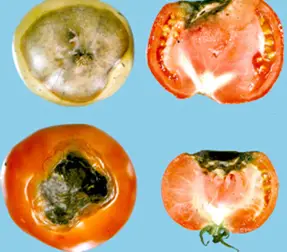
Sometimes, we mess up when we try to create the ideal environment for our crops.
For example, blossom end rot is caused by calcium deficiency. Tomato plants gather calcium from the soil around their roots as they create and grow their fruits.
When there is a fluctuation in soil moisture, the root’s ability to uptake calcium and other nutrients wane.
Wet and flooded soil also will dilute the minerals in the soil around the plant, washing away some and bringing in others. This inconsistency can create problems for a growing plant.
Another major contributor to calcium deficiency in the soil is fertilizing. When it comes time to pick a fertilizer, we must choose one that is well-balanced and designed for use in vegetable beds or specifically for tomato crops.
Excessive nitrogen in the soil can block out or limit the amount of calcium a plant can find.
Since nitrogen is a common ingredient in fertilizers, be sure to find a bag specifically designed for your tomato garden.
Also, be sure to read the instructions properly and thoroughly. Using too much of even the correct type of fertilizer can severely damage your plants.
You might also like: Why Are My Tomato Plants Not Flowering? (5 Causes + Fix)
What Happens When My Tomatoes Get Blossom End Rot?
It can be incredibly disheartening when you notice that your tomatoes have brownish-black spots on their blossom end (bottom).
Sadly, even if you catch blossom end rot early, you still cannot salvage the infected tomatoes.
Soon after the spot has emerged, secondary organisms and pests will invade the fruit through the brown area. They will eat the inside of the fruit and cause it to begin to rot from the inside out.
If you do not remove the infected tomatoes quickly, the insects can move into uninfected tomatoes, creating an infestation.
Removing the infected tomatoes immediately is the only way to avoid this scenario.
Luckily, blossom end rot tends only to affect the earliest maturing tomatoes. Therefore, this batch tends to ripen in late July or early August.
The good news is that once you remove these fruits, the plant will be told to produce more tomatoes, increasing your chances of a healthy and full summer yield.
How To Prevent Blossom End Rot?
There is no cure for blossom end rot. It is hard to reduce the chance of it happening once the tomato plant has experienced a severe calcium deficiency.
The best way to prevent blossom end rot is not to allow your tomatoes to experience a lack of calcium.
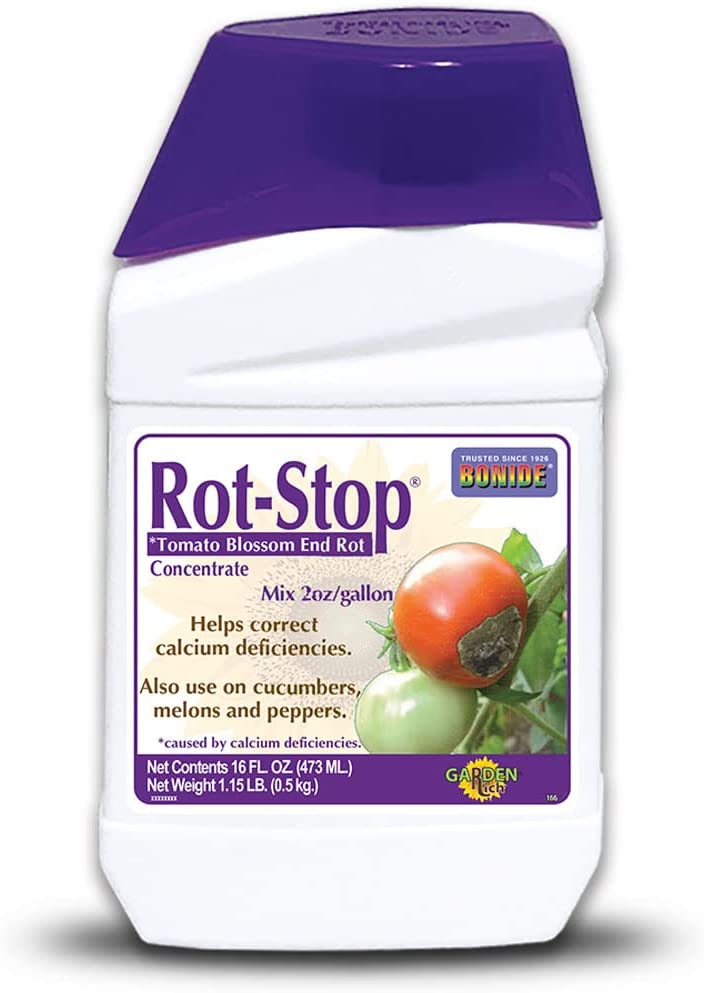
Water the tomatoes weekly. You may need to water more frequently in warmer or dry weather. The goal is to create a consistent moisture supply for the tomato plant.
However, you do not want to overwater. Wet and muddy soil can increase the chance of root rot for your plants. This can also lead to other problems like fungal diseases and harboring pests.
During the growing season, tomato plants need about 1 ½ inches of water per week. Keeping the moisture levels consistent reduces the chance of imbalanced calcium uptake from the root system.
In addition to keeping the watering schedule regular, you will want to apply mulch around your tomato plants.
This helps keep the moisture in the ground and prevents the soil from experiencing too much sun. In addition, this prevents the soil from drying out.
Another way to avoid blossom end rot is not using fertilizer for your tomatoes. Most garden soil contains enough nutrients for the season.
Planting your tomato seedlings in clean, fresh garden soil is the best way to ensure they are set up for success.
Never grow the same crop more than two years in a row in the same soil. By then, all the nutrients have been leached from the dirt, and the plant may suffer from deficiencies.
If you need to fertilize your plants, be sure to pick one appropriate for tomatoes. Read the instructions carefully and thoroughly, so you apply the correct amount.
Too much fertilizer can cause a wide range of issues, even death, for plants.
What Else Can Get Blossom End Rot?
If blossom end rot can destroy your tomato crops, what else can it affect?
Now that you know what a calcium deficiency can do, there are other crops you need to worry about. Peppers, eggplants, summer squashes, and watermelons can also be affected by blossom end rot.
Luckily, you now know the cause of this rather annoying disease so that you can protect your garden.
Like tomatoes, peppers and eggplants infected with blossom end rot tend to phase out after the first few fruits of the season grow.
Be sure to remove any infected fruits before they become infested with bugs. This will prevent the bugs from spreading to other healthy fruits.
Non-Effective Treatments
It seems that there is always a home remedy waiting to swoop in and save the day, and blossom end rot is no exception.
Treating blossom end rot is simple but time-consuming. The only way to treat it properly is to help your plant consistently access the soil’s calcium. This is done by watering regularly and deeply.
Any vegetable already emerged with the black cankers cannot be cured and must be discarded. Therefore, when we talk about treatments for blossom end disease, we are talking only of new vegetables that have not emerged yet.
When people hear that this is a problem caused by a lack of calcium, they come up with strange and unscientific solutions on how to quickly get calcium into the soil.
Sadly, there is no evidence that crushed eggshells, antacids, or milk sprays will do anything for your plants.
There are no “miracle fixes” for treating blossom end rot.
Other Types of Diseases Commonly Found in Tomatoes
But what if the black spots you see on your tomatoes are not caused by blossom end rot?
Many diseases can affect a tomato plant’s leaves, stems, and fruit. Identifying which one it is can be tricky.
Early Blight

Photo by Inga Meadows
(1) Effects on foliage, stems, and fruit of tomatoes
(2) Symptoms include dark spots with concentric rings that develop on older leaves.
Usually, the first leaves that touch infected soil show dark rings, and the surrounding leaf area may turn yellow.
When the leaves die off, they leave the young tomatoes exposed to the sun. This can result in sunburn. In addition to the leaves, the stem and the tomatoes can begin showing black spots.
(3) Early blight is a fungus that hides in plant residue and is soil-borne. This fungus can also be brought home in infected seeds or plants.
Once you notice your plant is infected, remove it immediately. Do not compost the plant, as the fungus lives in soil.
Instead, try adding a fungicide to the soil to prevent early blight infections.
Septoria Leaf Spot
(1) A fungal infection that affects the leaves of tomato plants.
(2) Septoria Leaf Spot will appear as small, dark circles growing to about ¼ inch in diameter. Once they grow, the center of the circles turns tan or gray, and the leaves fall off.
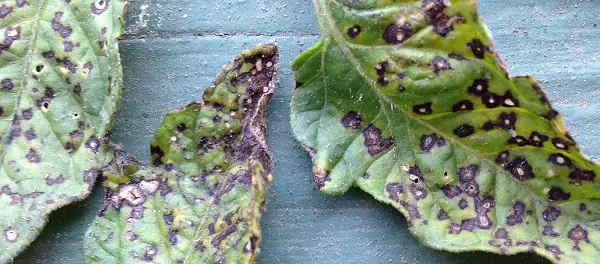
(3) If you catch it early, you can save your plant from Septoria Leaf Spot. Use a fungicide on the plant and remove all infected leaves.
Try to only water your plant at the base, as water droplets can cause the fungal spores to spread.
Bacterial Speck
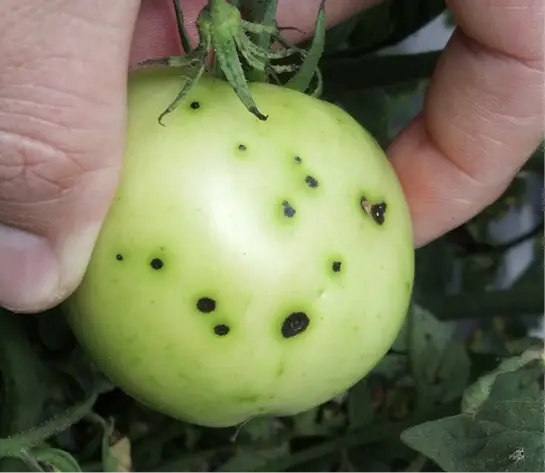
(1) A bacterial infection that affects the leaves and fruit of a tomato plant.
(2) Bacterial speck presents itself in tiny, dark spots with a yellow border. The spots will range in appearance; some will be raised, flat, or even sunken.
(3) There is no cure for Bacterial Speck. Remove infected plants as soon as possible.
Do not compost the plants, as the bacteria can spread to other plants quickly and easily. Always wash your hands and tools when working with plants.
Late Blight
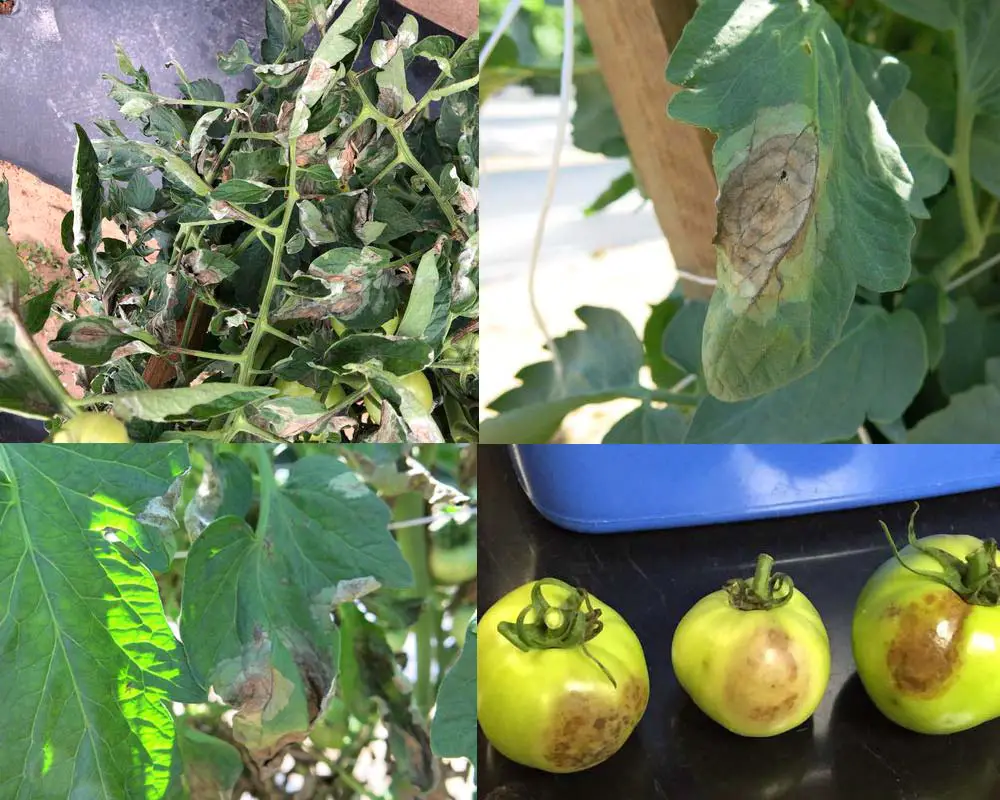
(1) A fungal infection that affects the leaves, stems, and fruit of tomato plants.
(2) Late blight presents itself with greasy-looking, irregular-shaped blackish blotches with greenish edges on leaves. It is not uncommon to find a ring of white mold around the spots, especially if the weather has been wet.
Stems of the plant may begin to grow black splotches, and the tomatoes will develop gray spots that turn to mush from bacterial infection.
Remove infected crops immediately. Late blight is transferred in soil, so do not compost the infected plant.
Another tip for avoiding late blight is not planting tomatoes or potatoes near one another. These crops are susceptible to this fungal disease, which can quickly wipe out your entire supply of tomato or potato crops.
Final Thoughts
Protecting our crops from diseases and pests can be a tiring job, especially when there are so many things out there that can cause them harm.
Large, black spots on tomatoes can be alarming. They can also signify that something is wrong with their growing conditions.
Unlike other diseases, like blight, septoria leaf spot, and bacterial speck, blossom end rot is not considered a disease. Instead, it is caused by a calcium deficiency in the growing tomatoes.
To prevent blossom end rot, be sure to water your tomatoes constantly and thoroughly. This will allow them to access the calcium in the soil.
Also, avoid over-fertilizing the plants; use clean and fresh garden soil each season to help keep the area nutrient dense.
Taking some time to care for and adequately diagnose your tomato plant’s ailment is the best way to ensure a healthy and bountiful harvest.
